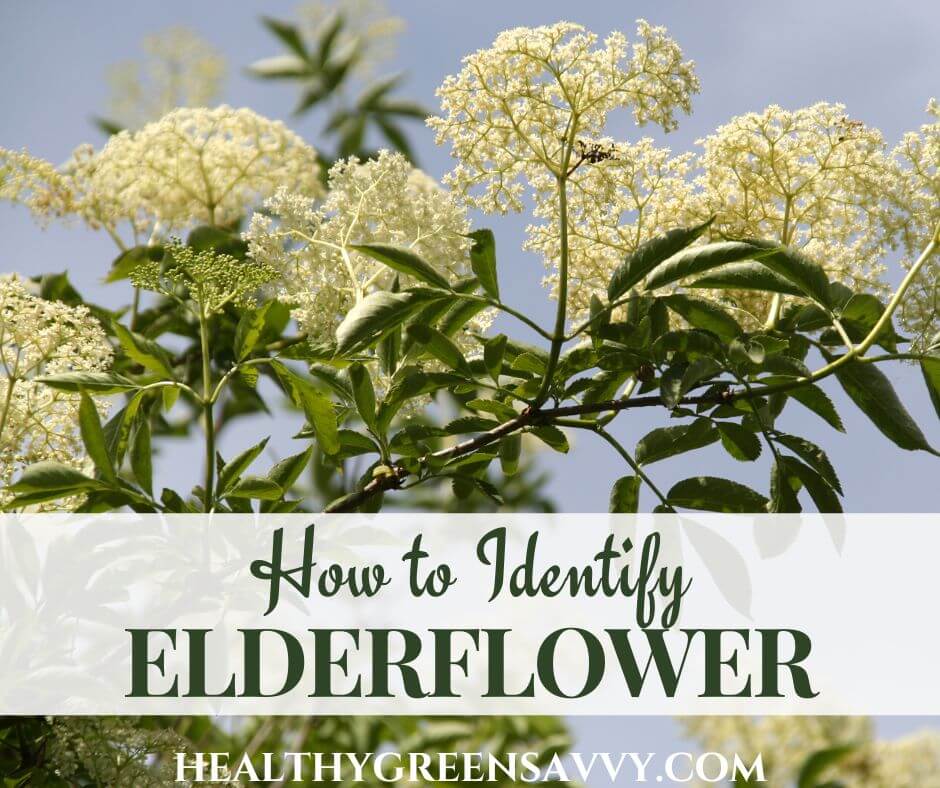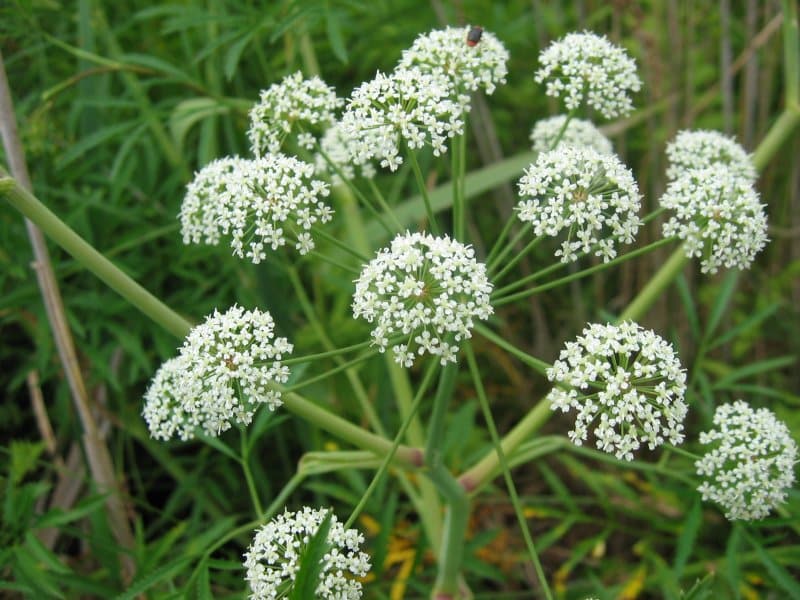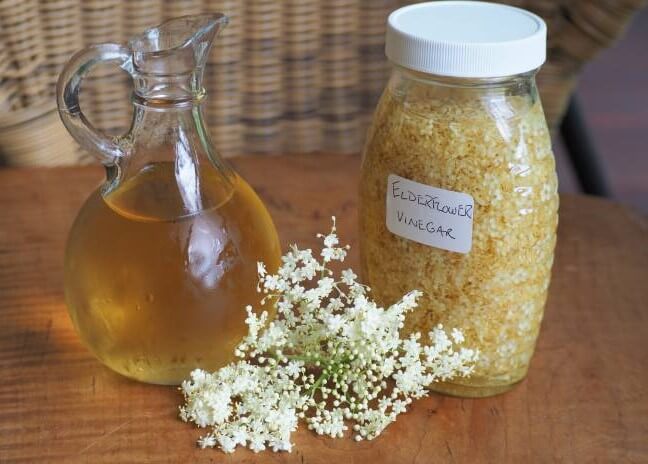Last Updated on September 17, 2024
Have you caught elderflower fever, too? More people have discovered the many delicious uses for elderflower with every passing year, so it’s crucial all those eager foragers know the basics of elderflower identification. If you’re planning on foraging elderberry flowers this season, be sure you know how to identify elderflower correctly and which elderflower look alikes you need to avoid.
Read on to learn all about foraging elderflower safely this season.

ELDERFLOWER IDENTIFICATION: FORAGING BASICS
The first rule of foraging is to be absolutely certain to correctly identify plants using multiple features. Elderflowers share some characteristics with several other flowers that are highly toxic. You need to look carefully to tell them apart, but once you’ve got the basics of elderflower identification, you’ll never mistake it for a toxic look alike.
*Be sure to use a good foraging guide or go with a veteran forager, and watch out for toxic plants that could be mistaken for elderflower.*
If you’d like to advance your foraging skills, be sure to check out the Herbal Academy’s online foraging course to master plant identification and ethical wildcrafting practices.
The second rule of foraging is to make sure you’re not collecting elderflowers or other plants from places that have been sprayed with toxic chemicals. You’ll often find elderflowers growing along railroad tracks, and unfortunately those are often sprayed with herbicides. We don’t rinse off elderflowers before using them, so avoiding collecting from places where harmful chemicals have been used is even more important.
Ready to learn about elderflower identification? Here’s what you need to know.
ELDERFLOWER IDENTIFICATION

Elderflowers typically begin blooming in late spring or early summer, depending on your climate. In milder climates, May is a traditional time to look for elderflowers, whereas up here in the north, we won’t see them until around the summer solstice.
They’re pretty easy to spot once they get going. Elderberry bushes will sport dozens of sprays of elderflowers, appearing covered with white at the height of the elderflower season.
HOW TO IDENTIFY ELDERFLOWERS
Remember it’s important when you forage to look not just at the flowers, but at the leaves, bark, and growth habit to determine that indeed it’s an elderberry bush you’ve found.
GROWTH HABIT
Elderflowers grow on bushes or trees, depending on which species of elderberry you’ve found. The Sambucus nigra found more commonly in Europe tend to take more of a tree form, as do the Sambucus cerulea that grow in the western half of North America. The Sambucus canadensis, known as the American elderberry, grow in a shrubby form.
All of these species are woody plants, not herbaceous ones. If you find something resembling elderflowers on a pliable, green stem rather than on a woody plant, you may have come across a toxic look alike and should give it a miss. More details on those in the section on elderflower look alikes below.
FLOWERS
Elderflowers grow in clusters of hundreds of tiny white blossoms called cymes, composed of many branching stems. The flattish flowerhead is pretty distinctive and will help you spot elderflower bushes. Cymes can range in size from just a few inches to the size of a dinner plate.

Each individual blossom measures about 1/4″ and has 5 petals and 5 stamens, which often are yellow in color.
LEAVES
Elderberry plants have leaves composed of multiple leaflets, usually between 5 and 11 in number. They grow opposite one another along the stem, with one leaflet at the end. Elderberry leaves are usually long and serrated, as seen in the photo below.

BARK
The bark of the elderberry plant is grey. It has raised bumps called lenticels, which allow gases to pass through it. It does not have thorns, so if you’ve found thorns on the plant, it’s not an elder.
I’m going to take some closeup photos this season, but until then this page has a helpful shot of an elderberry’s bark if you want to take a look.
HABITAT / WHERE DOES ELDERFLOWER GROW?
In Europe, you’ll typically find Sambucus nigra, the European elderberry. In North America, some wild plants may be nigra stock, but most in the eastern half of the continents are Sambucus canadensis (American elderberry). In the west, you’ll likely find Sambucus cerulea, the blue elderberry. All have edible blossoms.
Here’s a map showing where American elderberry grows and another showing where blue elderberry may be found.
You’ll spot elderflower plants along roadsides and the edges of public parks and farms. They often take root on the banks of streams and by railroad tracks as well. Note that plants by railroad tracks tend to have been sprayed with herbicides and are best avoided.
If you’re not sure where to find them in your area, ask in an online group and you may be surprised how many people keep tabs on these things.
ELDERFLOWER IDENTIFICATION: KNOW THESE ELDERFLOWER LOOK ALIKES
There are several elderflower look alikes to be aware of, some highly toxic, some not. As long as you use all the identifying features of the plant, you’re unlikely to mistake them for elderflower. But because they also have sprays of tiny white blossoms, they sometimes cause confusion for novice foragers.
Likewise with plants that have small purple berries. You’ll find some additional elder look alikes in a separate post on elderberry identification.
Remember to pay attention to all the features of the plant. Many of the poisonous look alikes below have very obvious differences from elderflower if you examine the leaf patterns or growth habit. Be sure to look at additional photos online so you have the fullest picture possible of the how these plants differ from elderflower.
WATER HEMLOCK (CICUTA MACULATA OR VIROSA)

Water hemlock, sometimes called spotted cowbane, is a VERY poisonous plant you need to recognize and distinguish from elderflower if you want to live to forage another day.
Remember that elderflowers grow on a woody shrub or tree? When very young, the immature stems of a small elder could resemble herbaceous plants. One of the most dangerous is water hemlock, which flowers around the same time and can grow up to 7 feet tall. Water hemlock prefers wet habitats, where we often also find elder plants growing.
Elderflower vs water hemlock:
- Water hemlock also has compound leaves, though they will be doubly or triply compound and are much spikier than elder’s.
- The umbels of the water hemlock have space between the smaller flower clusters, while elderflowers will not.
- Water hemlock stems are hollow rather than pithy.
- Water hemlock is herbaceous, and will not have bark like a mature elderflower plant
Here is a detailed description of water hemlock from Eat the Weeds. Read it carefully so you can give this plant wide berth.
GIANT HOGWEED

Also called giant cow parsley, giant hogweed has phototoxic sap, which causes severe burns if it gets on your skin and then is exposed to sunlight.
Giant hogweed (Heracleum mantegazzianum) has flat umbels of white blossoms that could be mistaken for elderflower. Thankfully, the plant itself looks very different, as this is another look alike to stay away from. A herbaceous plant, giant hogweed has bright green stems with purple blotches and white hairs.
Giant hogweed has huge, deeply lobed leaves that look nothing like the compound leaves of elders.
Here’s more on identifying giant hogweed as well as what to do if you accidentally touch it. This page from the New York Department of Environmental Conservation has a lot of helpful photos.
COW PARSLEY

Similar to water hemlock, cow parsley (Anthriscus sylvestris) is a herbaceous plant with wide spaces between flower clusters in its umbels. Though edible, because it’s not especially tasty and easily confused with toxic fool’s parsley (Aethusa cynapium), most experts don’t recommend foraging it. Here’s more on fool’s parsley so you can learn to avoid it.
COW PARSNIP

Cow parsnip (Heracleum sphondylium, lanatum, or maximum) resembles other umbellifers of the carrot family. It’s actually edible if you know what you’re doing, most important that you don’t confuse it with water hemlock or giant hogweed. Its sap can cause a phototoxic reaction if it gets on your skin and then you expose it to sun, though that doesn’t stop foragers who consider it quite tasty. Samuel Thayer includes it in his book, Nature’s Garden.
Here’s an overview of the differences if you’re curious. But you can easily see it’s not elderflower.
OTHER POSSIBLE ELDERFLOWER LOOK ALIKES TO KNOW
There are plenty of other plants that have sprays of white flowers, including rowan berry and other members of the rose family like hawthorn. I’ve seen pyracantha (another member of the rose family also known as firethorn), listed as a look alike, but compare the blossoms in the photo below to elderflower, and you’ll see how different they are.

Dogwoods and hydrangeas can also have white flowers, but you’d really have to not be paying attention to mistake these plants for elderflower. Here is more on dogwood identification if you’re curious.
Some other plants have elongated inflorescences that really don’t look at all like elderflowers, including false spirea, pokeweed, and Chinese privet. As you’ve probably gathered by this point, if it’s conical, triangular, or the flowers grow in a long line, it’s not elderflower.
Devil’s walking stick (Aralia Spinosa) is a tree with clusters of small flowers that has spiky thorns to help you distinguish it from elderflower, which is thornless. More details on identifying devil’s walking stick here.
RED ELDERBERRY

While red elderberry (Sambucus racemosa) isn’t technically a toxic look alike, it’s useful to know the difference between it and other elderflowers you might be foraging. Though some herbalists use the blossoms from red elderberry plants, the plant is higher in compounds that make people ill, and people tend to have trouble with the berries. If you’re sensitive to those compounds, you may want to proceed with caution before using the flowers from red elderberry plants.
Red elderberry flowers about one month earlier than the American elderberry and has a conical rather than flat cyme. Read more about identifying red berried elder.
TIPS FOR FORAGING ELDERFLOWER: HARVESTING & PRESERVING
Remember that picking elderflowers means the plant can’t make elderberries. It’s a good idea to leave some elder flowerheads so you can forage elderberries at the end of summer. Then use some to make homemade elderberry syrup, among the many other uses for elderberries to try.
When you collect your elderflowers, look for cymes where most blossoms are open and creamy white. If they’ve started browning, leave them to make berries and choose a fresher-looking umbel. If you’ve had heavy rains, it’s best to wait a couple of days to allow the flowers to produce more pollen, or elderflower’s signature flavor might be compromised.
Most elderflower fans say it’s preferable to collect elderflowers in the morning. I’ve found elderflowers foraged earlier in the day tend to have more pollen and fragrance, so they will likely impart a fuller flavor to your recipes.
Use a sharp scissors or shears to snip off the stem just below the flowerhead. To keep your elderflowers fresh, it’s helpful to bring along an insulated bag with some freeze packs. Put your elderflowers in a container in the bag, and they keep fresh much longer than if left out at higher temperatures.
The foraging season for elderflowers lasts 4 to 6 weeks. Flowerheads on each plant will bloom at different times, and plants in varying growing conditions will bloom at different times.
All those yummy-smelling elder blossoms attract a lot of insects, so give the flower heads a gentle shake to remove them before placing them in your basket. You can also handpick the more tenacious bugs.
–> Don’t wash your elderflowers or you’ll be removing a lot of the flavor you’re after.
If you love the idea of foraging edible flowers, be sure to check out more than 150 other flowers you can eat.
If you don’t have elderflowers growing near you, you can buy dried elderflowers online. Mountain Rose Herbs carries elderflower, along with scores of other high-quality herbs at very competitive prices. You might also try this bagged elderflower tea from Republic of Tea.
PRESERVING FORAGED ELDERFLOWERS

Elderflowers will have the best flavor if used right after picking. To avoid browning, refrigerate foraged elderflowers in a container for up to 24 hours.
Elderflowers may also be dried to use medicinally. Herbalist Matthew Wood reports that “fresh flowers more purgative, elderflowers also harder on stomach. Dried they lose purgative properties.” Warm infusions of dried elderflowers is often recommended for fevers.
HOW TO DE-STEM ELDERFLOWERS
While it’s easy to snip elderflower umbels from the bush, getting all those tiny blossoms off their stems can take a fair amount of work. For some recipes you can leave a little bit of stem, but for others you want to be certain you’ve removed all the stems. Stems can spoil the delicate flavor or elderflower and also contain compounds that upset stomachs.
While researching my book, Everything Elderberry, I got to hang out with elderberry growers, jam makers, herbalists, and a local distiller to learn how they used elderflower. I helped out with the destemming process while we chatted, and they shared their tips on the most efficient ways to destem elderflowers.

A local distiller destems enormous boxes of elderflowers each summer to use for his incredible elderflower liqueur. He used a comb to remove blossoms from a stem. A jam-maker used scissors to get blossoms for her elderflower cordial, but she picked off flowers with her hands for her elderflower strawberry jam. Allow time for whichever process you choose — it takes awhile!
One other option to consider: You can try shaking older elderflowers off the umbel into a container, leaving berries to form. It’s a bit fussy, but lets you have your (elderflower) cake and eat your elderberries, too 🙂
DRYING ELDERFLOWER
If you want to dry your elderflowers, leave the elder blossoms on their stems to dry. Removing them after drying is much easier.
To dry, place whole flowerheads face down on a drying screen or clean kitchen towel. You want the air to be dry and circulating so they dry quickly.
Keep in an airtight container for up to one year.
Preserving herbs for later use is a skill worth mastering. It’s so lovely to make flavorful meals and nourishing teas with herbs you’ve foraged or grown in summer.
FAQS
Where do you find elderflowers?
Keep an eye out when you drive along country roads during elderflower season, and you’ll likely spot many. Elderflower plants are also often along the banks of streams, at the edges of farms and parks, and along railroad tracks, though railroad companies tend to spray weed killer to control growth along the tracks.
When do elderflowers bloom?
Elderflower season begins in late spring or early summer, depending on where you live. The end of May is a traditional time to forage elderflowers in England, while in colder climates, they may not start appearing until the end of June.
Elderflower season may span more than six weeks, as individual plants will put out new blooms over a long period, and elderflower plants in shadier spots will start (and end) their blooming season later than those growing in sun. I’ve seen plants still putting out new flowers even as the elderberry season winds down in late August.
Can you eat the stems of elderflowers?
The compounds in elder plants that make people sick are more concentrated in the stems, bark, and leaves. American elderflower plants may have lower amounts than European ones, but in general it’s advised to avoid consuming the stem. One popular traditional recipe for elderflowers, though, is dipping entire flowerheads in batter and frying them, so people have consumed small amounts of stem for centuries.
Proceed with caution if you’re generally sensitive to these compounds. Many elderflower recipes use the blossoms only.
How do you prepare elderflowers?
If you’ve brought home a big harvest of elderflowers, you have some choices to make about how to use and preserve them. Definitely use some fresh, and dry some for use in elderflower tea later in the year. It’s among the many delicious wild teas you can forage.
You should probably also make an elderflower tincture, which will keep for years. Elderflower syrup and vinegar are other options.
For additional details and loads of yummy recipes, check out this post on using elderflower.
Now that you know about elderflower identification, head on out and find yourself some!
Save this info on foraging elderflower and elderflower identification for later!

Additional elderflower identification photo credits: cover — olaaf; pin — rozpedowski

Susannah is a proud garden geek and energy nerd who loves healthy food and natural remedies. Her work has appeared in Mother Earth Living, Ensia, Northern Gardener, Sierra, and on numerous websites. Her first book, Everything Elderberry, released in September 2020 and has been a #1 new release in holistic medicine, naturopathy, herb gardening, and other categories. Find out more and grab your copy here.



 Hi, I'm Susannah, a garden geek, energy nerd, and fan of healthy food and natural remedies. Need some simple, practical solutions for living healthier and greener? You've come to the right place! More about me and my green projects
Hi, I'm Susannah, a garden geek, energy nerd, and fan of healthy food and natural remedies. Need some simple, practical solutions for living healthier and greener? You've come to the right place! More about me and my green projects
Leave a Reply